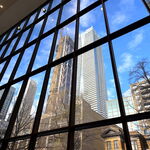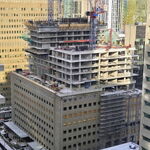drum118
Superstar
4550 Has enter service on 501 (501A)
4543 GPS still has the car at Bathurst Loop and thats wrong.
4543 GPS still has the car at Bathurst Loop and thats wrong.
The timestamp on that GPS location is about 10:20 this morning. Not so much wrong, as stale - if it was even real (which seems likely, given it's situated exactly where a car would sit on the tracks at Bathurst, behind other vehicles on the 511 platform).4543 GPS still has the car at Bathurst Loop and thats wrong.
Without bringing the situation to light in a public forum, going by the results of any previous investigation, it will not be published. There's only a few orgs in Canada that will release information freely, even if FOI mandates the release.
Anyone have any details on the last Ottawa DD bus crash investigation? How about many rail accident investigations? Often it takes the Safety Board to refer to reports not published, and the CTSB itself releases details gov't agencies refuse to.
What we still don't know about the fatal Ottawa bus crash | CBC News
Speaking of which:
Parliamentary committee wants Transportation Safety Board to oversee highway safety
ELIZABETH PAYNE Ottawa Citizen
Updated: June 11, 2019
https://ottawacitizen.com/news/loca...tation-safety-board-to-oversee-highway-safety
https://www.ourcommons.ca/DocumentViewer/en/42-1/TRAN/news-release/10557364
https://www.ourcommons.ca/Committees/en/TRAN/StudyActivity?studyActivityId=10485212
Yes the car was on the track early today and still showing it there now. If still there, how are the 511 buses servicing the station?? Last seen by the GPS was 10 hours ago..The timestamp on that GPS location is about 10:20 this morning. Not so much wrong, as stale - if it was even real (which seems likely, given it's situated exactly where a car would sit on the tracks at Bathurst, behind other vehicles on the 511 platform).
View attachment 190301

Lots of reports by TSB, here's one:As far as I know, TSB reports are published on their website. However, I'm not aware of any investigations that are held back; I only know what I read.
One thing that would have to be considered in discussion whether the TSB should investigate public road carrier/transit incidents is whether or not the federal government has jurisdiction (in addition to the obvious increase in staffing and related resources required). Are urban transit systems under federal or provincial authority? As far as I know, the TSB does not investigate rail incidents on the ONR.
Anyone can be compelled to be investigated by the CTSB if they are pertinent to a case file. It's in the enabling legislation.Any TSB investigation of urban transit and public road carrier incidents would be parallel to a police investigation since the TSB does not investigate fault. Given the scope of their investigations, which includes factors such as human dynamics, there would be a legal question whether a non-regulated employee (i.e. car driver) could be compelled to be investigated.
In Canada, that is still overlapping and not clear. The Ottawa Bus Crash is a case of overlapping jurisdictions, and still not fully clarified as to who is assigned to what, and how evidence will be presented in court.Case law abounds regarding the sharing of information between mandated regulatory cooperation and evidence exchange between regulators and law enforcement.
Which one? Even the military vs civilian authority delineation is murky in Canada.If a death is involved, we would now have the coroner and his legislation involved.
Excellent heads up. The anti-climb device and absorption bar appears slightly lower on the K/W model than the TTC ones, ostensibly since it doesn't have to mate with the CLRV one (which caused a derailment of an Outlook when it was pushing a stalled CLRV), and that article makes two very valid points:For the recent discussion about what sort of crash energy management is or isn't behind the panels of a Flexity, there's a good picture of the internals in this CTV news piece on the latest incident in Kitchener:
CTV Kitchener: https://kitchener.ctvnews.ca/collision-between-car-lrt-snarls-traffic-in-kitchener-1.4465095
All three situations would have mitigated damage and danger with a reactive bumper as defined, tested and espoused by the US Federal Transit Agency, and used as a matter of course in much of Europe, and now a number of US cities, especially in mixed vehicular traffic.This is the third crash involving an LRT vehicle in the last two weeks.
[...]
In that case, the LRT was damaged to the tune of about $20,000.
https://www.flickr.com/photos/kinkisharyo
This is exactly what is needed along with reactive systems as well as proactive for when the collision is unavoidable.Bombardier safety system to prevent light rail collision, overspeed
https://www.railway-technology.com/news/bombardier-introduces-light-rail-vehicle-safety-system/[...]
COMPAS is designed to prevent derailing and increase safety for tram drivers and passengers.
It builds on Bombardier’s Obstacle Detection Assistance System (ODAS ), which was introduced in Germany in 2017. Currently, ODAS has been selected by five light-rail vehicle operators.
The latest light-rail vehicle safety system is equipped with two driver assistance functions, vision-based speeding prevention and an automated obstacle detection system.
COMPAS enables the tram driver to utilise digital track data and visual odometry to operate the tram in pre-defined speed limits. Accordingly, the system improves the safety of passengers, as well as of pedestrians and other people around the running vehicle.
Bombardier Transportation Austria managing director Christian Diewald said: “We have completed the development phase of COMPAS and will shortly start the operational evaluation in two existing vehicle fleets.
“I am especially happy that we are testing this safety innovation in the new vehicles for our customer Wiener Linien in Austria, but also with our customer in Blackpool, UK.”
[...]
http://onlinepubs.trb.org/onlinepubs/circulars/ec112.pdf Pg 74, 75[...]


And yet again, you make my argument. Your logic implies even a strong wind could have deflected the LRT to derail. I think you'd best read the studies....not considering that the force required to deflect one set of trucks/segment is probably well within what is reasonable based on what we can guess (and this is all guessing at this point) the speed and direction of the vehicles were at impact.
He had absolutely no steering ability or braking beyond the automatic braking system that would have engaged. If he had steering, he would have kept it on-course for straight ahead, by far the safest tragectory, but of course, with the flanges out of the track (and a previous derailment the TTC put down to "leaves in the track groove" )(and someone had better think about that one!) there was no imparted directionality at all save for the limits of the articulation geometry stops.Once derailed the entire cars 48k kg and it’s inertia come into play - the vehicle still has to stop and IMO the operator/vehicle did an admirable job bringing it to a stop.
https://www.ijser.org/researchpaper/DESIGN-AND-DEVELOPMENT-OF-IMPACT-ENERGY-ABSORBING-BUMPER.pdf
[...continues with diagrams, photos, and detailed explanations for those that can read...]
http://www.kinkisharyo.com/projects/phoenix-az-valley-metro-rail-vmr/#phoenixPhoenix, AZ
Valley Metro Rail (VMR)
Challenge:
Meet specific aesthetic and safety requirements
Solution:
Precise engineering, pioneering design
VMR asked us to develop safe light rail vehicles that could run in city streets with mixed traffic and to fit in aesthetically with the Phoenix area. It required precise human and industrial engineering at every stage of the design process. To meet demanding safety requirements, we combined recessed couplers with a newly pioneered energy absorbent bumper cover design to reduce the effects from private vehicle to LRV collisions. Now service proven, these energy absorbent bumper covers have significantly reduced the damage to the LRV during a collision with a typical road vehicle such as a delivery truck or private auto.
Because it's pretty minor in the greater scheme of things. Dozens of people are run over by cars in Toronto every year on sidewalks and even in buildings. Some are even killed.Why are so many of you unconcerned with the elephant on the loose here? It was *out of contorl* until finally coming to a stop on a sidewalk thankfully empty at the time.
Lots of reports by TSB, here's one:
http://publications.gc.ca/site/eng/9.562206/publication.html
Anyone can be compelled to be investigated by the CTSB if they are pertinent to a case file. It's in the enabling legislation.
In Canada, that is still overlapping and not clear. The Ottawa Bus Crash is a case of overlapping jurisdictions, and still not fully clarified as to who is assigned to what, and how evidence will be presented in court.
Which one? Even the military vs civilian authority delineation is murky in Canada.
In the case of the last Ottawa bus crash, after lengthy tussles, it was determined to be the OPS with assistance from the CTSB.
TSB says Transport Canada has much to do in terms of safety regulations on transit vehicles
As to the exceptional powers of the Board, here's the empowering Act:
Canadian Transportation Accident Investigation and Safety Board Act
https://laws-lois.justice.gc.ca/eng/acts/c-23.4/fulltext.html
The TSB-ONR report was one of two on their website of reports back to 1991. I am aware that they can be requested to investigate by the non-federally regulated agency. They had a passenger train go on the ground in May 2018 and there is no indication that the TSB was involved.
Number and intensity of railway accidents in OntarioRegulation
Some of Ontario Northland’s rail operations are federally regulated. Specifically:
As a result of Ontario Northland’s unique status as an operational enterprise of the Province of Ontario, the balance of its rail operations are not federally regulated.
- The organization’s branch line from Swastika, Ontario to Rouyn-Noranda, Quebec is owned and operated by a federally registered company, Nipissing Central Railway.
- The Northlander passenger train operates on CN track between North Bay and Toronto and is also therefore federally regulated.
The organization has adopted federal regulations and standards, including those of the Railway Safety Act and self-regulates in this regard. In addition, the Company is active in the Railway Association of Canada and representatives participate on committees that draft regulations and rules for Transport Canada’s approval.
http://ontarionorthland.ca/sites/default/files/corporate-document-files/PBX-Investigation Report Summary.PDF[...]Ontario Northland commenced an investigation immediately following the incident. This investigation consisted of measuring, documenting and photographing all evidence, gathering all pertinent track and equipment data, performing an analysis of the locomotive event recorder download, and interviewing the employees directly involved including the operating crew and track maintenance personnel. The investigation identified the direct cause of the derailment to be human error by the operating crew unintentionally failing to comply with a speed restriction. The investigation also identified several recommendations to avoid a similar incident in the future. Ontario Northland will not be commenting further as the derailment is the subject of legal action against the corporation.
[...]
https://en.wikipedia.org/wiki/Tramway_trackThe invention of grooved rail enabled tramways to be laid without causing a nuisance to other road users, except unsuspecting cyclists, who could get their wheels caught in the groove. The grooves may become filled with gravel and dirt (particularly if infrequently used or after a period of idleness) and need clearing from time to time, this being done by a "scrubber" tram. Failure to clear the grooves can lead to a bumpy ride for the passengers, damage to either wheel or rail and possibly derailing.




